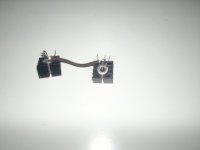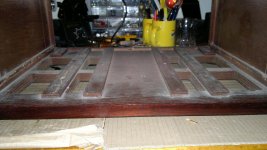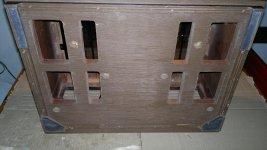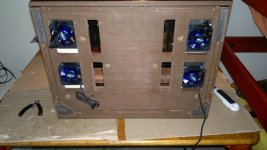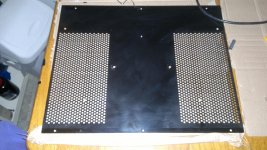I will let the amp run for at least one hour (if nothing go wrong) and I will continuosly check bias and temperature at regular intervals. I hope this will be the final test 🙂
Lets hope so, but you also have to have confidence in the work we have done.
That means testing the amp harder and harder and making sure the temperature remains acceptable and that the bias isn't creeping up to high.
That means testing the amp harder and harder and making sure the temperature remains acceptable and that the bias isn't creeping up to high.
After 30 minutes everything fine, I'm so happy right now 😀 (probably my neighbour is not in the same mood)
I regulate bias so it quite stable around 25mv, temperature on both heatsinks it's good too, I can keep my hand on them indefinitely
I regulate bias so it quite stable around 25mv, temperature on both heatsinks it's good too, I can keep my hand on them indefinitely
That sounds very promising but keep checking at least for the first few hours.
Touch wood 😀 its been an interesting exercise.
Touch wood 😀 its been an interesting exercise.
Thanks for the interest and kind words folks 🙂
----------------------------------------------------------------------------------------------------
Ian (Finch) mentioned in another thread about bias stability being hugely influenced by some amps having the cover removed. This is a very valid point and I'd like to suggest to gde3 that it could well be worth soldering some wires to the bias test points and running them outside the amp temporarily to see what the behaviour is when its all covered up. Make sure there is no possibility of them shorting to each other or to anything else. Remember it has to be right on the hottest of days and after hours of use at high levels.
http://www.diyaudio.com/forums/solid-state/235609-kenwood-ka-6100-bias-issues.html#post3482946
----------------------------------------------------------------------------------------------------
Ian (Finch) mentioned in another thread about bias stability being hugely influenced by some amps having the cover removed. This is a very valid point and I'd like to suggest to gde3 that it could well be worth soldering some wires to the bias test points and running them outside the amp temporarily to see what the behaviour is when its all covered up. Make sure there is no possibility of them shorting to each other or to anything else. Remember it has to be right on the hottest of days and after hours of use at high levels.
http://www.diyaudio.com/forums/solid-state/235609-kenwood-ka-6100-bias-issues.html#post3482946
Thanks everyone for the nice words, it was really an interesting project and I'm vey satisfied with the results.
Obviously my special thanks go to Mooly, without his kind and gentle tutoring this results wouldn't be possible. I learned a lot of things but I surely need to study some theory if I want to get more serious with this hobby.
My personal advice to anyone who want to start a restauration project is "be patient", for me it was hard to do that but it certanly paied off in the end.
By the way I'm continuing testing the amp, I want to be 100% sure everything is right and spending some more hours on it will not be a problem, especially since now I can listen to it 🙂
I did 3 one hour test sessions, with volume at 9,12 and 3 o'clock. I'm getting comparable results in term of bias and temperature and I discovered that the amp require 30-40 minutes to get to a stable temperature. Luckily the room where this amp will end up is underground so in the worse case temperature don't pass 20°, plus I will add four 6x6 fans on the bottom of the amp just to be sure.
Testing bias while the amp is in the case is something I was thinking about and is surely worth doing, but I have one more question about temperature, do I need to fit two heatsink on the new pre-drivers (MJE340-350)?
Obviously my special thanks go to Mooly, without his kind and gentle tutoring this results wouldn't be possible. I learned a lot of things but I surely need to study some theory if I want to get more serious with this hobby.
My personal advice to anyone who want to start a restauration project is "be patient", for me it was hard to do that but it certanly paied off in the end.
By the way I'm continuing testing the amp, I want to be 100% sure everything is right and spending some more hours on it will not be a problem, especially since now I can listen to it 🙂
I did 3 one hour test sessions, with volume at 9,12 and 3 o'clock. I'm getting comparable results in term of bias and temperature and I discovered that the amp require 30-40 minutes to get to a stable temperature. Luckily the room where this amp will end up is underground so in the worse case temperature don't pass 20°, plus I will add four 6x6 fans on the bottom of the amp just to be sure.
Testing bias while the amp is in the case is something I was thinking about and is surely worth doing, but I have one more question about temperature, do I need to fit two heatsink on the new pre-drivers (MJE340-350)?
I may have missed this, but I am still going to say it 🙂 You can simulate 'summer' by using a paint-stripper or hairdryer to heat the heat sinks.
Thanks everyone for the nice words, it was really an interesting project and I'm vey satisfied with the results.
Obviously my special thanks go to Mooly, without his kind and gentle tutoring this results wouldn't be possible. I learned a lot of things but I surely need to study some theory if I want to get more serious with this hobby.
My personal advice to anyone who want to start a restauration project is "be patient", for me it was hard to do that but it certanly paied off in the end.
By the way I'm continuing testing the amp, I want to be 100% sure everything is right and spending some more hours on it will not be a problem, especially since now I can listen to it 🙂
I did 3 one hour test sessions, with volume at 9,12 and 3 o'clock. I'm getting comparable results in term of bias and temperature and I discovered that the amp require 30-40 minutes to get to a stable temperature. Luckily the room where this amp will end up is underground so in the worse case temperature don't pass 20°, plus I will add four 6x6 fans on the bottom of the amp just to be sure.
Testing bias while the amp is in the case is something I was thinking about and is surely worth doing, but I have one more question about temperature, do I need to fit two heatsink on the new pre-drivers (MJE340-350)?
Did the originals have heatsinks ? How hot do they feel in use ? They are shown as passing around 8ma quiescent which is around the 0.6 to 0.7 watt mark. Its debatable whether they should or not have heatsinks. A small U shaped piece of aluminium would suffice if needed or you can get the "proper" thing. See how hot they feel.
I may have missed this, but I am still going to say it 🙂 You can simulate 'summer' by using a paint-stripper or hairdryer to heat the heat sinks.
Yep 🙂
Originally there's a small heasink, as you can see in the picture. This heatsink was directly screwed to the board. The problem with the new predrivers is that there isn't much operating space to put an heatsink (the board surface is close to the case, around 2cm) So there could be a risk of short circuit if the heatsink touch anything, plus I can't find a way to connect it to the board so it can't move.
The temperature on the predrivers don't seem high but I will check more extensively
The temperature on the predrivers don't seem high but I will check more extensively
Attachments
If they are reasonably cool there shouldn't be an issue. The MJE types conduct heat away via the thicker leads and into the PCB better which helps.
If it did need heatsinking then something small like this,
PF730 - AAVID THERMALLOY - HEAT SINK, TO-126, 34°C/W | CPC
If it did need heatsinking then something small like this,
PF730 - AAVID THERMALLOY - HEAT SINK, TO-126, 34°C/W | CPC
Hi please be careful if you install heat-sinks after you soldered the transistors. The PCB tracks are easily lifted if you apply force when tightening the mounting M3 screw and bolt.
Last edited:
A little update, after 50/60 hours the amp is running fine, I also quite like the sound is really warm but detailed, probably more close to a tube amp than a solid state. Sorry if I can't explain myself in a better way but is allready hard to describe sound in my own language 😀
To be sure the amp will last I added 4 fans and I removed the bottom (pictures will explain better).
Instead of the Noctua €15 I ended up using the Noise Blocker XR-2, 2200 rpm 15db 24m^3/h, for only €6. I'm really satisfied with this fan and I can strongly recommend it for audio equipment, if you need a small low noise fan this should be the right choice
To be sure the amp will last I added 4 fans and I removed the bottom (pictures will explain better).
Instead of the Noctua €15 I ended up using the Noise Blocker XR-2, 2200 rpm 15db 24m^3/h, for only €6. I'm really satisfied with this fan and I can strongly recommend it for audio equipment, if you need a small low noise fan this should be the right choice
Attachments
Unfortunately after around 300hr of use one of the channels is not working anymore. More specifically it still work (not shorts) but with an incredible amount of distortion and it's producing 1/20 of the power compared to the other channel.
At the beginning both channels where equal but after 200hr of playing the channel that now is broke was producing a little less power that the other (same bias) and it continued to lose power in the 100hr that followed.
For who remember I changed 2 out of 4 predrivers on this channel (while the one that work has all original predriver).
I tried checking the board but I can't spot any potential issue or damaged part, I can regulate bias and offset is fine. What should be my next step?
I still have some MJE350 avaiable to use as predrivers, could those be an issue?
At the beginning both channels where equal but after 200hr of playing the channel that now is broke was producing a little less power that the other (same bias) and it continued to lose power in the 100hr that followed.
For who remember I changed 2 out of 4 predrivers on this channel (while the one that work has all original predriver).
I tried checking the board but I can't spot any potential issue or damaged part, I can regulate bias and offset is fine. What should be my next step?
I still have some MJE350 avaiable to use as predrivers, could those be an issue?
Very strange problem... but don't just change any parts in hope. Sometimes its hard to tell in recordings exactly whats going on. Have you swapped the speakers over to see ? It doesn't sound like that sort of problem but lets eliminate them from the equation.
Studying the circuit again will have to wait until tomorrow 🙂 but if the output stage bias is correct and adjustable and the offset is OK then its an odd issue.
How loud was it when you recorded that clip ?
Does the distortion change with volume ?
Studying the circuit again will have to wait until tomorrow 🙂 but if the output stage bias is correct and adjustable and the offset is OK then its an odd issue.
How loud was it when you recorded that clip ?
Does the distortion change with volume ?
- Status
- Not open for further replies.
- Home
- Amplifiers
- Solid State
- Help repairing Pioneer M3
